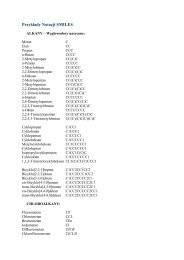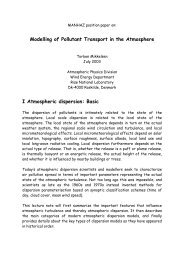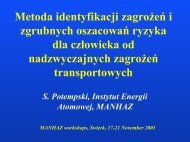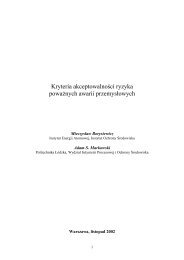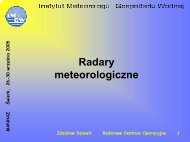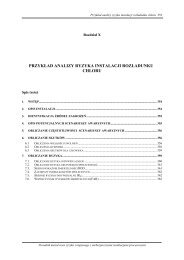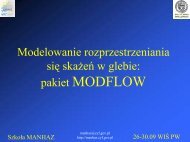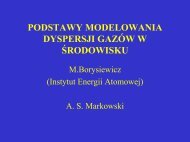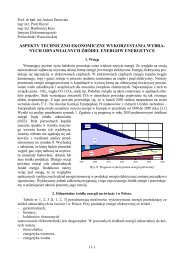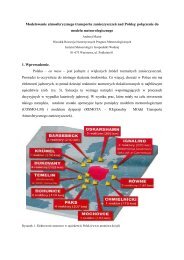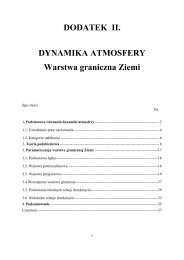presentation I - MANHAZ
presentation I - MANHAZ
presentation I - MANHAZ
Create successful ePaper yourself
Turn your PDF publications into a flip-book with our unique Google optimized e-Paper software.
EMEP long range transport air<br />
pollution models and their<br />
applications for policy making<br />
Jerzy Bartnicki<br />
Norwegian<br />
Meteorological<br />
Institute<br />
EMEP MSC/W<br />
(www.emep.int)
Outline of Part 1<br />
What is EMEP and why EMEP?<br />
Beginning of EMEP<br />
EMEP as a part of Geneva Convention (CLRTAP)<br />
Convention on Long-range Transboundary Air Pollution<br />
FIRST EMEP model<br />
EMEP UNFIED model (MSC-W)<br />
Heavy Metal model (MSC-E)<br />
POPs model (MSC-E)
What is EMEP and why EMEP?<br />
EMEP – Co-operative programme for monitoring and<br />
evaluation of the long-range transmission of air pollutants<br />
in Europe. Popular shorter name: European Monitoring and<br />
Evaluation Programme. At present international<br />
programme in the frame of Geneva Convention with more<br />
than 50 participating European countries.<br />
Emergency context: 1) Serious problem with acidification<br />
in Scandinavia in 1960s and 1970s 2) some of European<br />
forests reported dead in 1970s and1980s 3) nitrogen<br />
oxides, ozone, heavy metals, POPs and aerosol problems<br />
at present 4) experimental runs with radioactive debris
Beginning of EMEP<br />
Svante Oden – Sweden (1967) – first public warning:<br />
• precipitation all over Europe more acid and correlated<br />
with increase of SO 2 emissions<br />
• serious acidification of lakes in Scandinavia<br />
• acidification of forest soils<br />
Follow up OECD study with 11 participants, which<br />
concluded that:<br />
“air quality in any European country is measurably<br />
effected by emissions from other countries”<br />
and that<br />
“if countries find it desirable to reduce substantially the<br />
total deposition of sulphur within their borders individual<br />
national control programmes can achieve only a limited<br />
success”
Beginning of EMEP<br />
1977 – A new programme is established under UNECE:<br />
European Monitoring and Evaluation Programme for<br />
Transboundary Long-Range Transported Air Pollutants,<br />
EMEP. In total 25 European countries participated in the<br />
programme.<br />
Modelling in the frame of EMEP started at the Norwegian<br />
Institute for Air Research (NILU) and after a short period<br />
was continued at the Norwegian Meteorological Institute in<br />
Oslo, initially by the team of two scientists: Anton Eliassen<br />
and Jørgen Saltbones.<br />
1979 – EMEP becomes a part of the Geneva<br />
Convention: Convention on Long-range Transboundary Air<br />
Pollution (CLRTAP)
CLTRAP Convention<br />
(www.unece.org<br />
www.unece.org)<br />
November 1979 – signature of Convention by 34<br />
European Governments and European Community<br />
The Convention was the first international legally binding<br />
instrument to deal with problems of air pollution on a broad<br />
regional basis<br />
16 March 1983 – The Convention entered to force, 90<br />
days after it had been ratified by 24 Parties<br />
At present, there are more than 50 Parties to the<br />
Convention
Major principles of CLTRAP:<br />
a) The recognition that air pollution is a major problem;<br />
b) The declaration that Contracting Parties determined “to<br />
protect man and his environment against air pollution”<br />
would “endeavour to limit and, as far as possible,<br />
gradually reduce and prevent air pollution”;<br />
c) The commitment of Contracting Parties to ”by means of<br />
exchange of information, consultation, research and<br />
monitoring, taking into account develop without undue<br />
delay policies and strategies which shell serve as a<br />
means of combating the discharge of air pollutants,<br />
taking into account efforts already made at national and<br />
international levels”;<br />
d) The intention to use “the best available technology<br />
which is economically feasible” to meet the objectives of
Structure of CLTRAP and EMEP
Elements of the EMEP<br />
programme:<br />
programme<br />
1. collection of emission data (MSC-W);<br />
2. measurements of air and precipitation quality<br />
(CCC);<br />
3. modelling of atmospheric dispersion, using<br />
emission data, meteorological data, and functions<br />
describing the transformation and removal<br />
processes (MSC-W + MSC-E).
Anton Eliassen<br />
Jørgen Saltbones<br />
First EMEP model<br />
One layer, 2-D trajectory model for<br />
SO 2 and SO 4<br />
Backward 48 hours trajectories<br />
850 hPa wind, every 6 hours<br />
Constant mixing height 1000 m<br />
Constant dry deposition velocities<br />
Constant scavenging ratios<br />
127 km grid resolution
Development of the EMEP<br />
models<br />
Trajectory model for SO 2 and SO 4 only<br />
Implementation of nitrogen oxides<br />
Implementation of ozone chemistry<br />
First Eulerian multi-layer model<br />
Eulerian models for HM and POPs (MSC-E)<br />
Introduction of aerosol module<br />
EMEP Unified model
UNIFIED model -<br />
scientists<br />
Leonor Tarrason<br />
Project leader<br />
David Simpson<br />
Hilde Fagerli<br />
Chemistry<br />
Anton Eliassen - Leader<br />
Jan Eiof Jonson<br />
Ozone<br />
Peter Wind Svetlana Tsyro Vigdis Vestreng
EMEP UNIFIED model<br />
UNI - AERO<br />
EMEP acidification<br />
14 species, 4 size modes<br />
Aerosol dynamics<br />
Multimono<br />
Boundary, lateral and initial conditions<br />
Meteorological conditions<br />
Advection<br />
Emissions<br />
UNI - ACID<br />
EMEP acidification<br />
10 species + PPM<br />
Dry and Wet Deposition<br />
UNI - OZONE<br />
EMEP photochemistry<br />
69 species, 170 reactions<br />
PPM mass: 2 species
EMEP grid system
Vertical<br />
structure<br />
σ – co-ordinates<br />
20 layers +mid-layers
Vertical structure (cont.)
Model equation<br />
p − pT<br />
σ<br />
=<br />
p*<br />
*<br />
p = p − p<br />
S<br />
T
Advection<br />
Bott 4 th order - horizontal<br />
Bott 2 nd order with variable grid distance in<br />
vertical<br />
Pure air is also advected to conserve mass<br />
After each advection step the new mixing<br />
ratios are calculated:<br />
C<br />
p<br />
t+<br />
∆T<br />
x<br />
*<br />
=<br />
* t+<br />
∆t<br />
x = * t+<br />
∆t<br />
( Cair<br />
p )<br />
p<br />
S<br />
(<br />
C<br />
−<br />
p<br />
T<br />
p<br />
)
Meteorological data
Vertical diffusion<br />
K z calculated first based on local Richardson<br />
numbers for the entire 3D model domain.<br />
These values are applied above the PBL and<br />
for stable PBL<br />
O’Brien (1970) profile is used to calculate<br />
K z (z) for unstable boundary layer<br />
PBL is calculated based on NWP data and K z<br />
and there are limits: 100m < PBL < 3000m
Anthropogenic emissions<br />
Sulphur dioxide (SO 2 )<br />
Nitrogen oxides (NO x =NO+NO 2 )<br />
Ammonia (NH 3 )<br />
Non-methane volatile organic compounds<br />
(NMVOC)<br />
Carbon monoxide (CO)<br />
Particulates PM 2.5 and PM 10
Sector 1<br />
Sector 2<br />
Sector 3<br />
Sector 4<br />
Sector 5<br />
Sector 6<br />
Sector 7<br />
Sector 8<br />
Sector 9<br />
Sector 10<br />
Sector 11<br />
Agriculture<br />
Source sectors<br />
Combustion in energy and transformation industry<br />
Non-industrial combustion plants<br />
Combustion in manufacturing industry<br />
Production processes<br />
Extraction and distribution of fossil fuels and geothermal energy<br />
Solvent and other product use<br />
Road transport<br />
Other mobile sources and machinery (including ship traffic)<br />
Waste treatment and disposal<br />
Other sources and sinks
Emissions<br />
VOC – VOC emissions are specified in each<br />
sector<br />
Aircraft– seasonally averaged aircraft<br />
emissions are included for NO x as 3D fields.<br />
Shipping – emissions included in sector 8<br />
NMVOC – emissions calculated as function of<br />
temperature and solar radiation<br />
DMS – mantly average emissions as SO 2<br />
Lightning - monthly average 3D NO x fields<br />
Volcanoes – included for Italy
Land use<br />
data<br />
16 classes<br />
Same for<br />
deposition<br />
modelling and<br />
biogenic<br />
emission<br />
calculation
Initial and boundary conditions<br />
Four methods currently available:<br />
1. 3D fields from previous runs of the same or<br />
another version of the Unified model<br />
2. 3D fields from observations<br />
3. 3D fields from global chemical transport<br />
model<br />
4. Prescribed concentrations in terms of latitude<br />
and time of the year (or time of the day)
Chemical species<br />
Chemical species<br />
MACRO2<br />
MVKO2<br />
MALO2<br />
MEKO2<br />
OXYO2<br />
PRRO2<br />
ETRO2<br />
ISRO2<br />
SECC4H9O2<br />
C2H5O2<br />
CH3O2<br />
HO2<br />
OH<br />
OP<br />
OD<br />
Short-lived:<br />
PMco<br />
PM2.5<br />
AMNI<br />
AMSU<br />
NH3<br />
pNO3<br />
SO4<br />
SO2<br />
CH4<br />
CO<br />
H2<br />
C2H5OH<br />
CH3OH<br />
ISNIRH<br />
ISONO3H<br />
MAR2O2H<br />
CH3COO2H<br />
H2O2<br />
ISRO2H<br />
MARO2H<br />
MVKO2H<br />
MALO2H<br />
MEKO2H<br />
OXYO2H<br />
PRRO2H<br />
ETRO2H<br />
secC4H9O2H<br />
C2H5OOH<br />
CH3O2H<br />
ISOP<br />
OXYL<br />
C3H6<br />
C2H4<br />
NC4H10<br />
C2H6<br />
CH3CHO<br />
HCHO<br />
MVK<br />
MEK<br />
MAL<br />
MGLYOX<br />
GLYOX<br />
ISNIR<br />
ISNI<br />
MACR<br />
CH3COO2<br />
CH2CCH3<br />
HNO3<br />
ISONO3<br />
N2O5<br />
NO3<br />
MPAN<br />
PAN<br />
NO2<br />
NO<br />
O3<br />
Advected species
Abbreviations
Abbreviations
Photolysis<br />
reactions
Chemical<br />
reactions
Chemical<br />
reactions
Chemical<br />
reactions
Chemical<br />
reactions
Chemical<br />
reactions
Chemical<br />
reactions
Chemical<br />
reactions
Chemical reactions<br />
Numerical solution – the chemical equations are<br />
solved using TWOSTEP method tested by Verwer<br />
and Simpson (1995).
Dry deposition of gases<br />
dCi ( zref<br />
) Vg<br />
⋅Ci<br />
( zref<br />
= −<br />
dt ∆z<br />
V<br />
g<br />
=<br />
R<br />
a<br />
1<br />
+ R<br />
b<br />
+<br />
R<br />
c<br />
)
Dry deposition for aerosol<br />
dCi ( zref<br />
) Vg<br />
⋅Ci<br />
( zref<br />
= −<br />
dt ∆z<br />
Vg υs<br />
R R R R υ +<br />
1<br />
=<br />
+ +<br />
a<br />
b<br />
Bounce-off effect is calculated for aerosols<br />
a<br />
b<br />
s<br />
)
Wet deposition:<br />
in-cloud in cloud<br />
scavenging<br />
For soluble component C:<br />
∆C<br />
wet<br />
=<br />
Win<br />
⋅ P<br />
−C<br />
∆z<br />
⋅ ρ<br />
w
Wet deposition: below-cloud<br />
below cloud<br />
For gases:<br />
∆C<br />
For particles:<br />
∆C<br />
wet<br />
wet<br />
=<br />
scavenging<br />
=<br />
Wsub<br />
⋅ P<br />
−C<br />
∆z<br />
⋅ ρ<br />
−C<br />
A⋅<br />
P<br />
⋅ E<br />
V<br />
dr<br />
w
Aerosol dynamics<br />
AEROSOLS: SO4, NO3, NH4, organic carbon (AC),<br />
elemental carbon (EC), mineral dust,<br />
sea salt (NaCl)<br />
Four modes:<br />
1. nuclation (d < 0.02µm)<br />
2. Aitken (0.02 µm < d < 0.1 µm)<br />
3. accumulation (0.1µm < d < 2.5 µm)<br />
4. coarse (2.5 µm < d < 10 µm)<br />
• Calculation of particle mass and number<br />
distributed in four modes, aerosol chemical<br />
composition, as well as, concentrations of PM 2.5<br />
and PM 10 .
Computer implementation<br />
1. Parallel design<br />
2. Code in FORTRAN 90<br />
3. Computer in Trondheim – SGI Origin 3800<br />
4. One year run requires 11 hours real time on 32 MIPS<br />
R14000 1200 Mflops processors<br />
Synchro<br />
Meteo10%<br />
10%<br />
Adavectio<br />
n<br />
10%<br />
Chemistry<br />
70%<br />
CPU usage
Heavy metal model (MSCE-HM)<br />
(MSCE HM)<br />
Eulerian 3D, 5 layers<br />
Pb, Cd, Hg<br />
50×50km, 135×11 grid cells
POP model (MSCE-POP)<br />
(MSCE POP)<br />
Eulerian 3D, 5 layers<br />
HCB, PCBs, γ-HCH<br />
50×50km, 135×11 grid cells
Hemispheric model (in development)<br />
MSC-E MSC<br />
Eulerian 3D, 8 σ-layers<br />
HCB, PCBs, γ-HCH, Pb, Cd, Hg<br />
2.5 o ×2.5 o
Future of EMEP models<br />
• Hemispheric or global approach<br />
• Improvement of aerosol module<br />
• Increased resolution in the large cities<br />
• Data assimilation<br />
• Closer cooperation with the Parties



